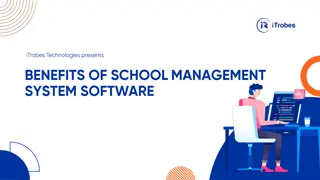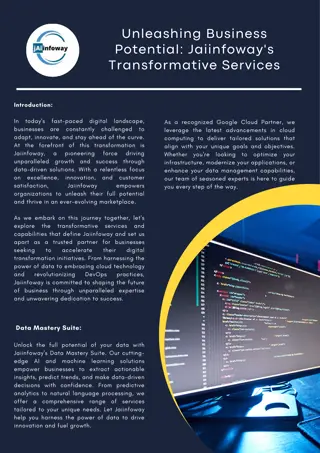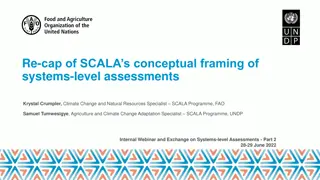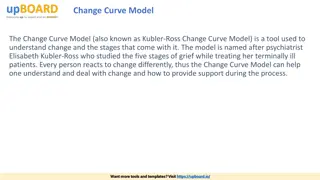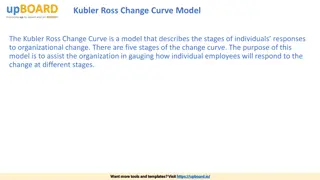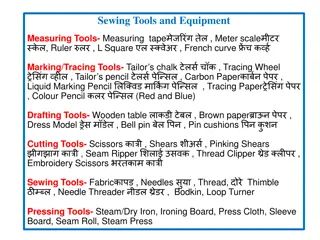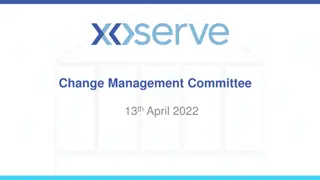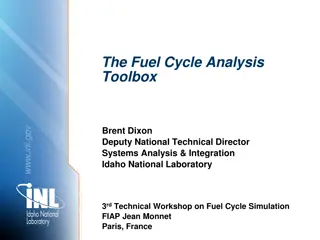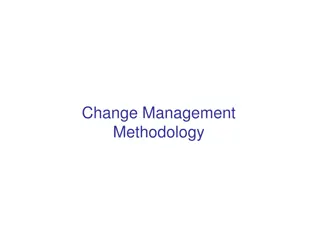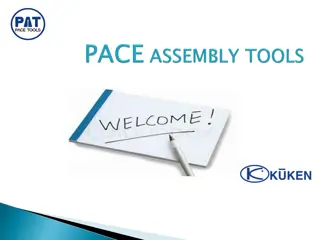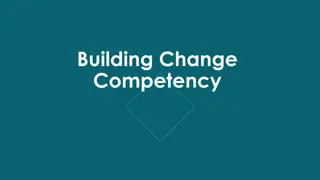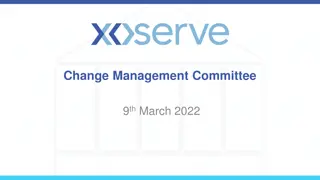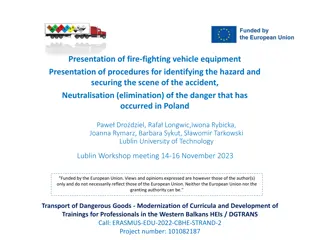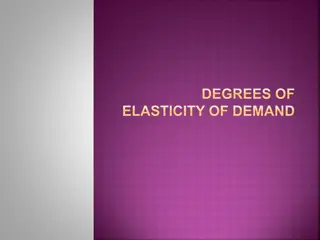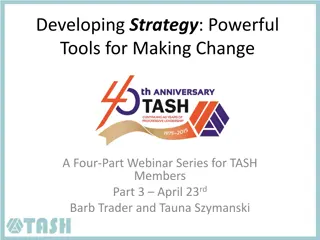Tools for Dealing with Transformative Change
Strategies and tools for navigating personal, team, and patient-level transformative change, focusing on self-awareness, sharing experiences with colleagues, and understanding psychological processes to move forward with awareness. Explore transitional and transformational change models, as well as common experiences in each phase of change.
Download Presentation

Please find below an Image/Link to download the presentation.
The content on the website is provided AS IS for your information and personal use only. It may not be sold, licensed, or shared on other websites without obtaining consent from the author.If you encounter any issues during the download, it is possible that the publisher has removed the file from their server.
You are allowed to download the files provided on this website for personal or commercial use, subject to the condition that they are used lawfully. All files are the property of their respective owners.
The content on the website is provided AS IS for your information and personal use only. It may not be sold, licensed, or shared on other websites without obtaining consent from the author.
E N D
Presentation Transcript
Strategies and Tools to deal with transformative change at a personal, team and patient level. Strategies and Tools to deal with transformative change at a personal, team and patient level. PAN BC 2022 Annual AGM and Education Day April 30, 2022 Conference Theme: Resilience
Learning Objectives Learning Objectives 1) Clarity on how you deal with transformative change at a personal level and what you learned about yourself. 2) Connect with colleagues to share tools and strategies that got you through the past 20 months. 3) Understand the psychological process of what actually happens in transformation and how you, your team and patients can move though with awareness.
1.Working at your tables, one at a time, say your name and where you work. 2. Answer the question without responding to anyone else s comments. In the past 20 months, What did you learn about yourself and what is important for you at this time?
Transitional Change Transitional Change New Stat e T Tr ransition State ansition State Ol Old State d State 6 Source: AckermanandAckermanAnderson(2001)
Transformational Change Transformational Change Success Success Plateau Plateau Re Emergence Through Visioning and Learning Wake Up Calls Wake Up Calls Growth Growth Chaos Death: Mindset Forced to Shift Birth Birth 7 Source: AckermanandAckermanAnderson(2001)
Personal Awareness of Change Personal Awareness of Change ENDINGS ENDINGS EXPLORATION EXPLORATION NEW BEGINNINGS NEW BEGINNINGS + Denial Enthusiasm Anxiety Energy Shock Hope Productivity Morale Fear Impatience Anger Acceptance Creativity Frustration Scepticism Confusion - Stress Avoidance Source: Bridges Model
Common Experiences in Each Phase Endings Neutral Zone New Beginnings Resentment towards the change initiative Low morale and low productivity Anxiety about their role, status or identity Skepticism about the change initiative Fear High energy Denial Openness to learning Anger Renewed commitment to the group or their role Sadness Disorientation Frustration Uncertainty A sense of loss
At your current tables: 1. Describe clearly and specifically: How did you move through the change and emotional triggers successfully? 2. What is one thing you would do differently next time?
Personal Awareness of Change Personal Awareness of Change ENDINGS ENDINGS EXPLORATION EXPLORATION NEW BEGINNINGS NEW BEGINNINGS + Be Empathetic Celebrate Success Mark the Ending Build Alliances Acknowledge Losses Discuss the New Future Productivity Morale Reinforce need for Change Challenge to Take Action Share Information Provide Training Provide Structure Define Roles & Responsibilities Celebrate Progress Encourage Personal Responsibility - Ensure Meaningful Work Be Approachable Source: Bridges Model
How You Can Provide Support How You Can Provide Support For whatever comes up feelings or emotions. Hold space without judgment. Hold Space Provide them with an acknowledgement of who they are as a person, their work and efforts, and ask how you can support them. Acknowledge Them Match their energy and body language (fast paced, slower paced).Write down what they said, read it back and ask if there is anything else. Match Them Allow them to go through whatever they are going through. Things might be coming up for them from the past this is a gift. Give Them Space Ask them whether they are open to questions. If you re offering suggestions or advice, ask if they are open to it. Ask Permission Engage them at eye level so they feel seen and heard without responding. Engage Them
Additional tools for you, your team and patients to move through transformation
Coping Model Coping Model Stephen Covey Stephen Covey Proactive Control Influence Reactive Concern
Fixed vs Adaptive Mindset Fixed vs Adaptive Mindset
Managing Energy Levels Managing Energy Levels At Work At Home Energy Boosters Energy Drainers
Managing Energy Levels Managing Energy Levels Assess our energy balance To manage anxiety in the face of adversity To support self management and resilience as leaders Manage complaints and turn them into opportunities Identify energizers and drainers to bounce back with minimal impact on team s functioning Skills to deliver under pressure To maintain a positive relationship with your team, even through hurdles, conflict and disagreements
Top Eight Reasons Change Fails Failure Failure Description Description Leaders aren t being clear on why we need to change so it is compelling and shakes people out of complacency. Leaders haven t communicated what the world will look like when we have changed in a way that makes it attractive enough so people will want to go there. 1 1 2 2 Leaders haven t communicated the practical and doable steps that will get us there so it makes sense and gives people confidence that the leaders know what they are doing. 3 3 Leaders themselves are not demonstrating support for the change, so people don t feel they need to either. Leaders don t change themselves; the way they do things, the things they say. It s called walking the talk . That means that the culture doesn t change. 4 4 5 5 Communication is poor, non-existent, or once-off. Employees are not involved; the change is done to them. Leaders don t understand the impact of change on people and worse, they don t seem to care so trust is eroded fast. 6 6 7 7 The change doesn t get bedded down because leaders turn their attention to other things too early. I call it Leadership ADHD . Rosalind Cardinal. Leading Change. Turning Change Fails into Change Success. E-book 8 8
Personal Awareness of Change Personal Awareness of Change Research on the brain suggests we perceive social threats and rewards Research on the brain suggests we perceive social threats and rewards the same way we process physical threats and rewards. the same way we process physical threats and rewards. When our social environment is rewarding rewarding or safe we think more rationally, make better decisions and are more willing to move When our social environment is threatening threatening, we react in a way that moves away away from the threat (i.e. defensive, avoidant, disengaged) safe, toward toward our goals Our role is to create a safe environment where employees feel they can Our role is to create a safe environment where employees feel they can contribute to the conversation. contribute to the conversation.
Personal Awareness of Change Personal Awareness of Change Status Certainty Autonomy Relatedness Fairness AWAY TOWARD From Threat Response Reward Response 7 Source: SCARF model, David Rock
Thankyou! Please feel free to reach out at Chantalnormandcoaching@gmail.c om


